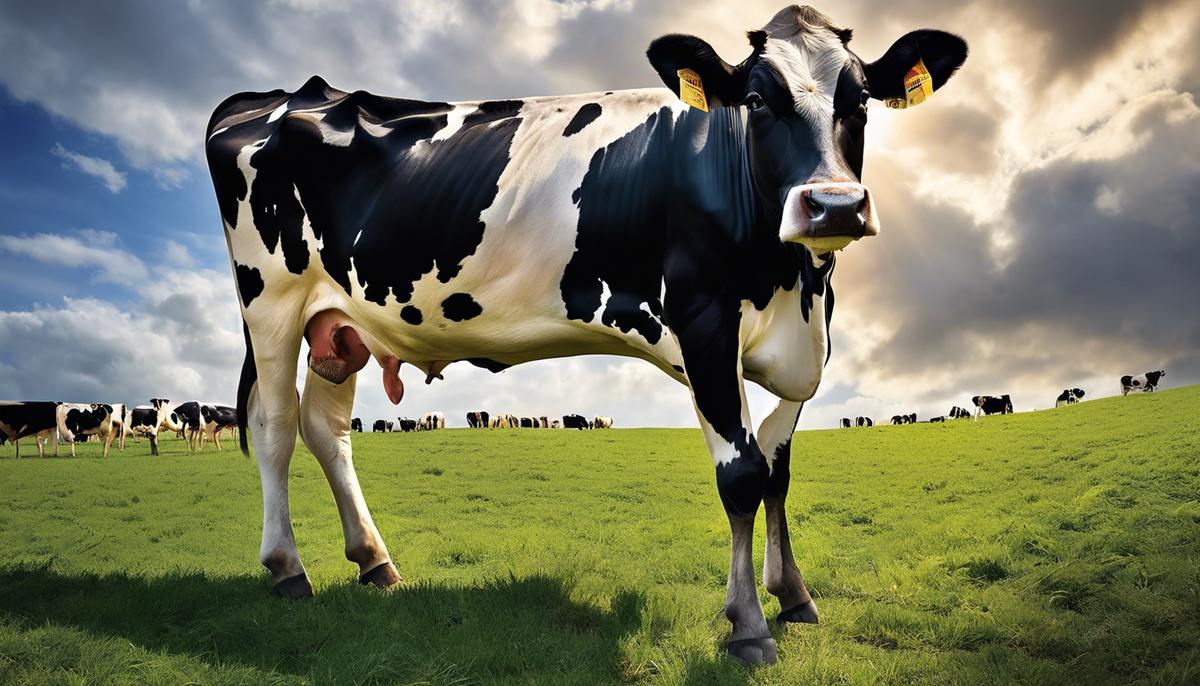.jpeg)
All about modern dairy farming
Description: With every fresh sunrise, a collection of bovines convene around automated milking systems that seamlessly extract their produce, epitomizing the fusion of technology and agriculture in the landscape of modern dairy farming. This intricate interplay between centuries-old tradition and contemporary innovation has revolutionized the industry, ushering in an era that is marked by increased productivity and sustainability. As our world responds to the pressing exigencies of climate change and ethical responsibility, dairy farming too is evolving, harnessing cutting-edge technology and strategic practices to address environmental concerns, foster animal welfare, and ensure economic viability. Through a fusion of history, technology, ethics, economy, and future trends, this discourse offers a comprehensive exploration into the riveting world of modern dairy farming. Modern technology and research have drastically transformed various aspects of life, where the agricultural sector – particularly dairy farming – has not been an exception. In fact, this industry has undergone sort of a technological revolution over the past few decades, giving rise to advanced dairy farming techniques that have significantly increased productivity, improved animal welfare, and enhanced environmental sustainability. This article delves into the innovative mechanisms through which technology has accelerated dairy farming methods. One of the remarkable advancements that have revolutionized dairy farming is robotic milking systems. These automated technologies allow cows to be milked without direct human labor, fostering increased efficiency, and minimizing human error in the milking process. Robotic milking systems have not only enhanced the productivity of farms but also promoted cow comfort and welfare since they enable milking in accordance to the individual cow's lactation needs rather than a set schedule. Feed management is another area where technology has played a formidable influence. Precision feeding technologies are helping farmers to optimize nutrition and reduce wastage. Using real-time data collected from the animals and from the field, the technology allows for adjustments to dietary needs minimizing costs and the environmental footprint. Modern technologies have also had a significant impact on herd management. Wearable devices with GPS tracking, temperature, and rumination sensors allow farmers to monitor the location, health, and welfare of each animal in real-time. Moreover, artificial intelligence algorithms can predict which cows are likely to become sick or be in heat, facilitating proactive interventions. On the environmental front, technological advancements have enabled precision manure management. Advanced systems, such as geographic information system (GIS) mapping, and new machinery permit precise application of the right amount of manure nutrients where they are needed in the field, minimising runoff and emission of greenhouse gases. Furthermore, modern research has led to the development of dairy herd improvement programs. These initiatives leverage new genetic technologies to accelerate the genetic improvement of dairy cattle. Selective breeding methods have become more precise with genomic selection, accurately predicting a cow’s genetic value for traits such as milk yield, fat content, and disease resistance, thereby improving the genetic quality of herds and ensuring efficient and sustainable milk production. In this era of personalized dairy products, research has allowed for the optimization of milk's nutritional and functional properties. Through the manipulation of feed composition and feeding strategies, researchers have succeeded in modifying the fatty acid profile of milk, enhancing the concentration of beneficial compounds. In conclusion, it is indeed impressive to witness how modern technology and research have significantly evolved dairy farming techniques. These advancements are not just about improving productivity and cost-efficiency but also ensuring animal welfare, environmental sustainability, and better health outcomes for consumers. As such, embracing the technological revolution is paramount for the continued success and resilience of our dairy industry in the face of emerging challenges. Considering the rapid evolution of technology, it can be anticipated that the next few years will be a fascinating period of both novelty and transformation for the dairy farming sector. As our discussion on dairy farming continues, it becomes increasingly clear that we're living in a defining moment for this industry. The adaptations and innovations of today are forging a more sustainable, efficient, and eco-friendly future for us all. Building on the broad themes already broached - such as robotics, AI, genetic tech, and more - let's delve deeper into other sustainable practices taking root in dairy farming. Perhaps one of the most notable of these is the utilization of anaerobic digestion. This method works to reduce the environmental impact of dairy farming by transforming livestock manure into renewable energy sources. The practice works by using a biological process to break down organic material in an oxygen-free environment – a process that forms biogas. This biogas can then be converted into heat, electricity or as a liquid fuel replacement for gasoline and is considered a significant contributor to greenhouse gas emission reductions. Another environmental innovation seen in dairy farming is the implementation of cutting-edge irrigation technology. Accurate and efficient water administration takes center stage in sustainable farming, with farmers increasingly turning to solar-powered, GPS-directed irrigation systems. This technology enhances precision, efficiently using essential resources, and mitigating water wastage – one of the prime concerns in farming practices globally. Further, sustainable dairy farming is adopting holistic approaches like agroforestry, where trees and shrubs are incorporated into farmland. This method facilitates natural nutrient cycling, reduces soil erosion, and enhances biodiversity, bolstering the farm's resiliency against adverse climatic conditions. For instance, trees on dairy farms serve multipurpose roles such as providing shade to cows while also acting as 'carbon sinks', capturing and storing CO2 and significantly contributing to reduction in climatic warming. Cover cropping, a time-honored farming technique, has also found a place in modern sustainable dairy farming. These strategically chosen crops are planted during off-seasons to improve soil health, boost nutrient content and lessen the dependence on chemical fertilizers, hence reducing the potential for toxic runoff into surface water sources. On the animal nutrition front, the practice of feeding cattle with additives like algae or seaweed has gained considerable attention. Certain strands of seaweed bear unique properties with the potential to reduce enteric methane emissions in cows, an immensely promising breakthrough for the industry. Similarly, the incorporation of nitrogen inhibitors in cow feed impairs the conversion of nitrogen into ammonia in the rumen, reducing the release of nitrogen into the environment. Dairy farming innovates tirelessly to enhance both sustainability and productivity. The sustainable practices being implemented – advanced irrigation, cover cropping, anaerobic digestion, incorporation of agroforestry, algae-enriched feed, and more – all reflect this commitment, spearheading a transformative movement. The future of dairy farming is one where technological progress and sustainability intermingle, each ensuring the other's survival, shaping an industry that honors its symbiotic relationship with the earth. Indeed, the industry's continuous evolution heralds that a fruitful, sustainable future awaits. In addition to the evolution in feeding technologies and herd management via wearable devices, an indifference to change has been replaced with an all-embracing attitude towards innovation for improved outcomes in animal welfare, environmental sustainability, productivity, and ultimately, consumer health. Significantly, anaerobic digestion presents a compelling solution to environmental concerns associated with dairy farming. By breaking down organic matter in the absence of oxygen, this process transforms manure into biogas, a clean, renewable source of energy. This not only reduces dependency on fossil fuels but helps in curtailing greenhouse gas emissions - thereby addressing environmental concerns while simultaneously augmenting energy supply. Contemporary dairies are also leveraging the latest irrigation technologies, critically aiding water conservation and making farms more resilient to climate change. These cutting-edge systems deliver precise amounts of water to specific areas of cultivable land, reducing runoff, preventing soil erosion, and promoting healthy crop growth – all of which contribute to long-term sustainability and enhanced dairy nutrition. The adoption of agroforestry practices and cover cropping are making notable contributions to the sustainability of dairy farming. By growing trees alongside pastures, farmers are able to curb carbon emissions, improve animal welfare through natural shade and windbreaks, while also diversifying income streams through timber and fruit production. Similarly, cover cropping aids in enhancing soil health, reducing the need for chemical fertilizers while preventing soil erosion and improving water quality. Moreover, feeding cattle additives like algae or seaweed is emerging as a scientifically backed method for reducing methane emissions. These additives, when included in cattle feed, inhibit methane-producing microbes in the cow’s rumen, thereby mitigating the environmental impact. Incorporating nitrogen inhibitors in cow feed presents another promising intervention by reducing the release of nitrogen into the environment through excreta, aiding in the reduction of harmful nitrous oxide emissions. In sum, dairy farming today navigates under the helm of technological progress coupled with a commitment to environmental sustainability. The industry’s willingness to incorporate innovative practices underscores a symbiotic relationship between dairy farming and the environment, a harmony that promises sustained evolution in the industry's approach to animal welfare, and its footprint on the planet. Together, they paint a picture of profound change and potential in an industry fixated on marrying tradition with technology, in the quest for sustainable, ethical dairy production. While much has been said about various technologies and their implications on the dairy farming industry, one must also address the economic viability of these decisions and the strategic use of technology and modern farming methods. An analytical approach reveals that these strategies can not only increase productivity of dairy businesses, but also contribute to greater financial resilience in the face of shifts in the market and climate-related challenges. Particularly in the United States, dairy farming has traditionally been a business of slim margins, heightened by the volatility of global dairy markets and susceptibility to weather variations. However, such pressures hope to be assuaged with the introduction of the Internet of Things (IoT) on dairy farms. IoT allows dairy farms to be more predictive than reactive or even preventive, leading to potential cost savings, increased yield, and improved animal welfare. For instance, sensors that monitor milk yield and quality in real time can aid in detecting an illness before it manifests, potentially saving thousands in veterinary costs and lost yield. Furthermore, the use of big data is becoming more prevalent in the dairy industry. From genomics to milk output, data collection and analysis aid in making informed management decisions. Predictive analytics help dairy farmers make decisions in barn management, nutrition, reproduction, and health, with the ultimate goal of increasing production while reducing costs. It is the strategic use of this type of technology that will inevitably make dairy businesses more economically viable. Another crucial aspect of modernizing dairy farming is exploring alternative energy solutions to reduce costs and environmental impact. Consider the use of anaerobic digesters that convert manure to biogas, a renewable energy source. This affects the profitability of dairy operations by providing an additional income stream through the sale of excess electricity back into the grid. Moreover, the process reduces the farm’s carbon footprint, a progression in line with the growing consumer preference for sustainability. The adaption of agroforestry practices and cover cropping also contributes to the economic viability of dairy businesses through soil conditioning, water conservation, and the reduction of dependency on chemical fertilizers. These practices often decrease feed costs, as improved soil health can lead to higher yielding, nutrient-rich pastures. Finally, strategic feeding - leveraging premium feeds fortified with additives like algae, seaweed, or nitrogen inhibitors - though more upfront-expensive, can result in long-term economic benefits. For one, these feeds are discovered to reduce methane emissions, easing the industry’s environmental impact. More importantly, they have been shown to improve overall cow health and productivity, significantly influencing the farm's bottom line. The dairy industry, in its essence, is a dynamic, evolving enterprise. The journey of modern dairy farming has not been one of instant transformations but a steady progression of improved practice and adaptability, fueled by technology and strategic methodologies. The nexus between these advanced tools and their economic benefits is evident - supporting these strategies' economic viability. A decade hence, the landscape of the dairy industry will likely be a testament to the benefits of embracing these technologies with an economically sound rationale. As we look towards the future of dairy farming, it is as if we are standing at the vanguard of an exciting new epoch. Advancements in technology and innovative research pursuits are carving inventive avenues that hold the potential to drive this industry into an era marked by increased efficiency, sustainability, and economic viability. Innovation and technology have the capacity to transform every aspect of a dairy farm. One example of this is the emergent use of the Internet of Things (IoT) in the field. When linked with the power of big data, IoT provides farmers with significant opportunities. For instance, farmers can closely monitor the efficiency of their operations with colossal amounts of data collected from various digital devices, improving decision-making. An extension of this technology, sensor-driven technologies are being integrated into farming operations. Instruments like soil moisture sensors, weather station data, and cow monitoring apps assist in making knowledgeable decisions, helping to conserve resources and amplify yields. Furthermore, biosensors, small devices that can detect biological elements, are another potent tool. When attached to a cow, it can offer management optimization by providing data regarding metabolic problems, reproductive conditions, animal welfare, and even monitor the emission of harmful methane gas. Another promising technology and research pursuit pivoting the future direction of dairy farming is alternative energy solutions. Especially relevant in this milieu is the production of biogas from manure through anaerobic digesters. This dual-purpose innovation addresses two significant challenges: dealing with vast amounts of waste as well as high energy costs. When processed appropriately, manure can become an invaluable asset, generating heat and electricity for the dairy farm, thus reducing dependency on external energy sources. The economic viability of the dairy farming industry is also being increased through alternative farming practices such as agroforestry and cover cropping. Such methods aid in soil conditioning and reducing dependency on chemical fertilizers, besides presenting numerous benefits like erosion control, enhanced biodiversity, and improved soil fertility. Meanwhile, researchers are working diligently to find feed additives that could effectively reduce the methane emissions of cows. Ingredients such as seaweed and nitrogen inhibitors show promising reductions of the potent greenhouse gas, while also meeting the nutritional requirements of the animals and minimizing nitrogen load on environment. Indeed, the current trajectories of technology and research pursuits within dairy farming represent a dynamic, symbiotic relationship between man, beast, and nature. Technological tools, methodologies, and research pursuits are acknowledging the reality of slimming margins, hazards of climate shifts, and environmental concerns, and are birthing transformative solutions to tackle these hurdles while increasing efficiency and sustainability on the farms. New avenues for the dairy sector are being forged that recognize the inevitability of change and the potential for growth amid challenge. As we look towards the horizon, what we see is a portrait of a sustainable, efficient, and economically viable dairy industry. What was once perceived as a humble, traditional pursuit is transcending those bounds and becoming a beacon of technological integration, built upon the foundation of conscientious attention to animal welfare and environmental impact. It is a portrait of a future forged by the commitment to advancement and change and one that holds great promise for the evolution of our world's nutritional landscape. The incessant march of technology and the increased global focus on sustainability and ethics will continue to shape the contours of the dairy farming industry. Leveraging these advancements and ideologies, dairy farming now promises a future of refined automation, precision farming, and greater respect for animal welfare. With thoughtful strategies and steadfast commitment, the industry is emerging as a model of sustainable and benevolent production, safeguarding the welfare of its bovines while producing high-quality dairy products for the world. As it embarks on this journey towards efficiency and harmony, dairy farming assures a resilient and productive future, resonating with the evolving sensibilities of our global society. The landscape of the modern dairy industry is ever-evolving, shaped by a symphony of technological innovations, sustainability efforts, shifting consumer preferences, and policy adaptations. As society marches into an era where information reigns supreme, understanding the trajectory of this vital sector is of both public interest and necessity. From robotic milking machines that dance rhythmically in the predawn light to the genetic architectures that promise healthier, more productive cattle, these are not the dairy farms of yesteryear. Embracing prospective changes, the industry continuously innovates, ensuring it remains at the cutting edge of agricultural production while navigating the intricate dance of satisfying market demands and honoring environmental stewardship. This essay ventures into the heart of these developments, casting a discerning eye on the pulse of an industry in transformation—a journey into how the white rivers of milk flow more intelligently, sustainably, and responsively than ever before. The field of dairy farming is experiencing a profound transformation fueled by technological advancements. This modernization is not only reshaping traditional practices but also enhancing productivity, animal welfare, and environmental sustainability. Robotic Milkers and Automation: Central to this evolution are robotic milking systems, which allow cows to be milked on demand, reducing stress and potentially improving milk quality. Automated feeders and barn cleaners are also becoming standard, optimizing the use of resources and decreasing labor costs. Precision Dairy Farming: Precision dairy farming is another pioneering approach, relying on sensors and data analytics to monitor the health and well-being of individual cows. By gathering information on activity levels, milk components, and rumination patterns, farmers can swiftly address health issues and tailor nutritional plans. Genetic Technology: Advancements in genetic testing are empowering dairy farmers to make informed breeding decisions, leading to herds that are healthier and more productive. Genomic selection has become a cornerstone of herd improvement programs, with potential benefits including increased milk yield and disease resistance. Sustainability Innovations: Addressing environmental concerns, new technologies facilitate the reduction of greenhouse gas emissions through precision feeding and manure management systems. These not only help in curbing excessive nutrient runoff but also pave the way for renewable energy generation from biogas. Digital Integration: The adoption of digital platforms helps in managing the day-to-day operations of a dairy farm with greater ease and precision. By centralizing record-keeping and analysis, farmers can make data-driven decisions that drive productivity while ensuring the welfare of the herd. Overall, the infusion of technology into dairy farming practices is crafting an industry that is more efficient, resilient, and aligned with societal expectations of animal care and environmental stewardship. As research continues and technologies develop, the dairy sector stands on the cusp of further innovations that promise to redefine the centuries-old practice of dairy farming. The quest for sustainability within the dairy industry continues with fervent dedication to reducing environmental impact while maintaining, and indeed often enhancing, productivity levels. As such, strides in eco-friendly feed practices are at the forefront of contemporary research and application. A paramount consideration within the realm of sustainable dairy production is the optimization of cattle feed for nutritional efficiency. This efficiency ensures that cows gain more energy and nutrients from less feed, thereby reducing the resources necessary for production. Forage science has seen notable progress here, developing hybrid grasses and silage crops that provide higher nutritional content and digestibility. Moreover, there is an active movement towards non-GMO forages, which helps mitigate the ecological concerns associated with genetically modified organisms. Another innovative approach within eco-friendly feed practices involves the integration of by-products from other agricultural sectors as cattle feed. For instance, brewers' grains, a byproduct of the beer industry, can be utilized as a protein-rich feed source. This not only prevents waste but also reduces the need for traditional grain feed which is resource-intensive to produce. Additionally, the inclusion of dietary additives is being explored to reduce methane emissions from cows, a significant greenhouse gas contributing to climate change. Certain additives have shown promise in inhibiting the production of methane during digestion, thereby reducing the overall carbon footprint of the dairy farm. Researchers are meticulously examining the long-term impacts and efficacy of these supplements, striving to comprehend the complexities of ruminal microbiota and its interaction with various additives. Simultaneously, industry leaders and scientists are collaborating to improve livestock management practices that promote better soil health and pasture management. This holistic approach integrates the well-being of the cow with the ecological integrity of the land on which it grazes, resulting in a synergistic effect that bolsters sustainability. Through these advancements in eco-friendly feed practices, the dairy industry makes considerable strides towards a balance between the demands of productivity and the imperative of environmental stewardship. The contemporary dairy industry is navigating a complex landscape of shifting consumer habits and expectations, which significantly influence its operational methodologies and product offerings. Notably, one of the critical changes comes from the rising demand for plant-based alternatives to traditional dairy products. The Growth of Plant-Based Alternatives Within the realm of consumer preferences, the surge in plant-based alternatives is undeniable. With a growing portion of the population adopting vegetarian or vegan lifestyles, in part due to ethical, environmental, or health considerations, the dairy industry is witnessing a reduction in the demand for conventional milk. In response, dairy farms and companies are increasingly expanding their product lines to include plant-based milk alternatives such as almond, soy, oat, and coconut milks. This diversification strategy ensures that these entities remain relevant and competitive in an evolving market. Consumer Health Consciousness Another pivotal factor is the health consciousness of consumers. There is an increased scrutiny regarding the nutritional value and the presence of hormones or antibiotics in dairy products. To maintain consumer trust, the dairy industry is adapting by promoting organic dairy products, which assure customers of product purity and the absence of synthetic additives. Furthermore, there is a significant emphasis on providing clear and transparent product labeling that communicates the health benefits and nutritional content of dairy goods. Demand for Ethical and Traceable Dairy Ethics and traceability are paramount concerns for today's informed consumers. The awareness around animal welfare has led to consumers demanding that dairy comes from farms using humane practices. Consequently, there is a rise in the certification of dairy products to guarantee that they meet specific welfare standards. Additionally, the concept of farm-to-table traceability allows consumers to understand the origins of their dairy consumption, fostering a connection between consumer choices and the impacts on farming practices. Ethnic Dairy Applications The globalization of palates and the multicultural fabric of society have introduced ethnic dairy products to a broader audience. Products like kefir, quark, and various types of artisanal cheeses are gaining popularity, prompting dairy producers to explore and incorporate these items into their production repertoires. Such diversification not only satisfies the adventurous consumer but also opens up new markets and revenue streams for the industry. Conclusion In summary, the current trajectory of consumer behavior is signaling a transformative period for the dairy industry. The sector is tasked with embracing alternative dairy options, transparent and health-conscious production processes, ethical standards, and the introduction of unique, culturally diverse products. As the industry adapts to these evolving preferences, the anticipation is that it will continue to innovate and consequently maintain its relevance in the lives of consumers globally. Policy shifts in the dairy industry are multifaceted and influential, mobilizing a broad spectrum of operational transformations that directly influence the quality, safety, and economic viability of dairy products. This treatise will elucidate on the reverberations policy changes enact upon the actuality of dairy production and management. Further governmental regulations regarding animal welfare introduce a paradigm shift towards improved living conditions for dairy cattle. Enhanced standards demand modifications to housing, increasing space per animal, and ensuring better access to veterinary care. Such advancements in animal welfare not only improve the quality of life for livestock but also potentially elevate milk yields and quality through the mitigation of stress-related impediments to production. Meanwhile, climate change directives are imposing stricter emission controls on the agricultural sector. New guidelines task dairy farms with the implementation of eco-friendly manure management systems. These include anaerobic digesters, which convert waste into biogas and usable fertilizers, thus reducing greenhouse gas emissions and providing renewable energy sources. This conversion of waste into assets not only adheres to environmental policies but also augments the overall efficiency and self-sustainability of dairy operations. The nutritional composition of dairy products is also under scrutiny, compelling the industry to adapt. Policies are increasingly favoring the reduction of added sugars, fats, and salts in food products, pushing dairy processors to reformulate or introduce novel product lines that cater to these health-oriented consumer demands. This may involve fortifying milk with additional nutrients like omega-3 fatty acids or producing low-lactose dairy products for lactose-intolerant populations. Lastly, trade agreements play a pivotal role in the accessibility and affordability of dairy commodities on a global scale. Shifts in tariffs and subsidies can alter the competitive landscape, influencing everything from the cost of production to the retail pricing of dairy goods. This necessitates strategic responses from dairy producers – either by finding efficiencies to offset costs, diversifying product portfolios to hedge against market volatility, or exploring new markets for export. Conclusively, policy-induced modifications in the dairy industry are compelling entities within the domain to re-evaluate and innovate across the entirety of their operations. These alterations are not merely a reactionary endeavor but are also guiding principles that shape the future trajectory of dairy production and distribution for the well-being of consumers, animals, and the environment alike. The dairy industry stands at a crossroads, with every path forward paved by the innovations and challenges of our time. As we have seen, technology is revolutionizing the way we produce milk, while sustainability and environmental consciousness guide the hands of dairy farmers toward greener pastures. The clamor of an informed consumer base, hungry for ethically produced, environmentally friendly dairy products, continues to echo through the marketplace, shaping the future with every conscious choice. Amidst this change, the intricate web of policy and regulations ensures the industry moves not only with economic efficiency but with a moral compass attuned to the broader societal good. While the rivers of milk continue to flow, they now take new directions—charting courses that are reshaping our world one innovation, one policy, one consumer choice at a time.All about modern dairy farming
The Evolution of Dairy Farming
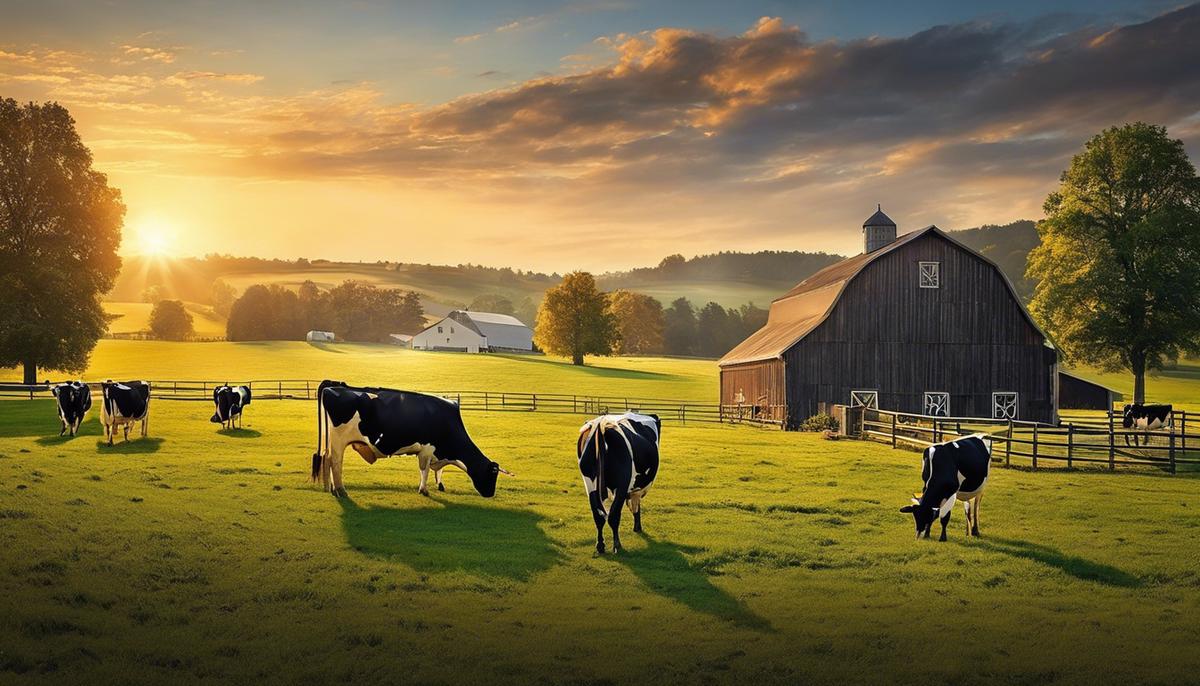
Sustainability in Dairy Farming

Animal Welfare in Dairy Farming
Technological advancements and conscientious management methodologies have opened new avenues for addressing dairy animal welfare concerns, while propelling dairy farming towards sustainable practices.
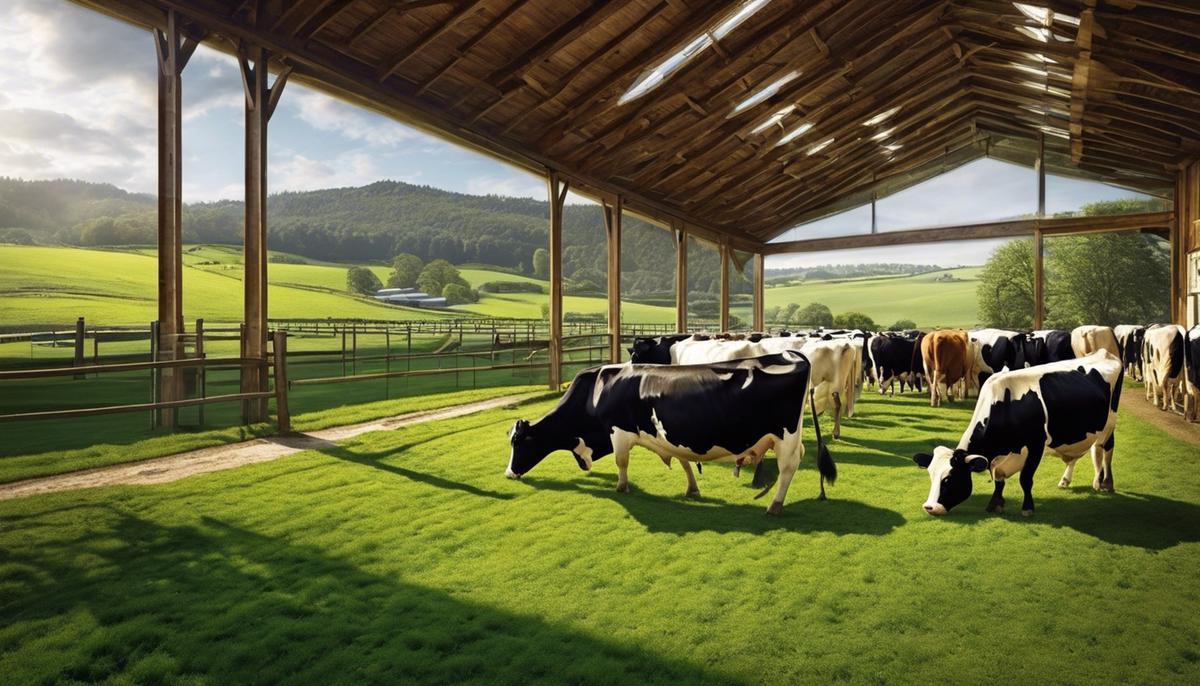
Economic Considerations of Modern Dairy Farming
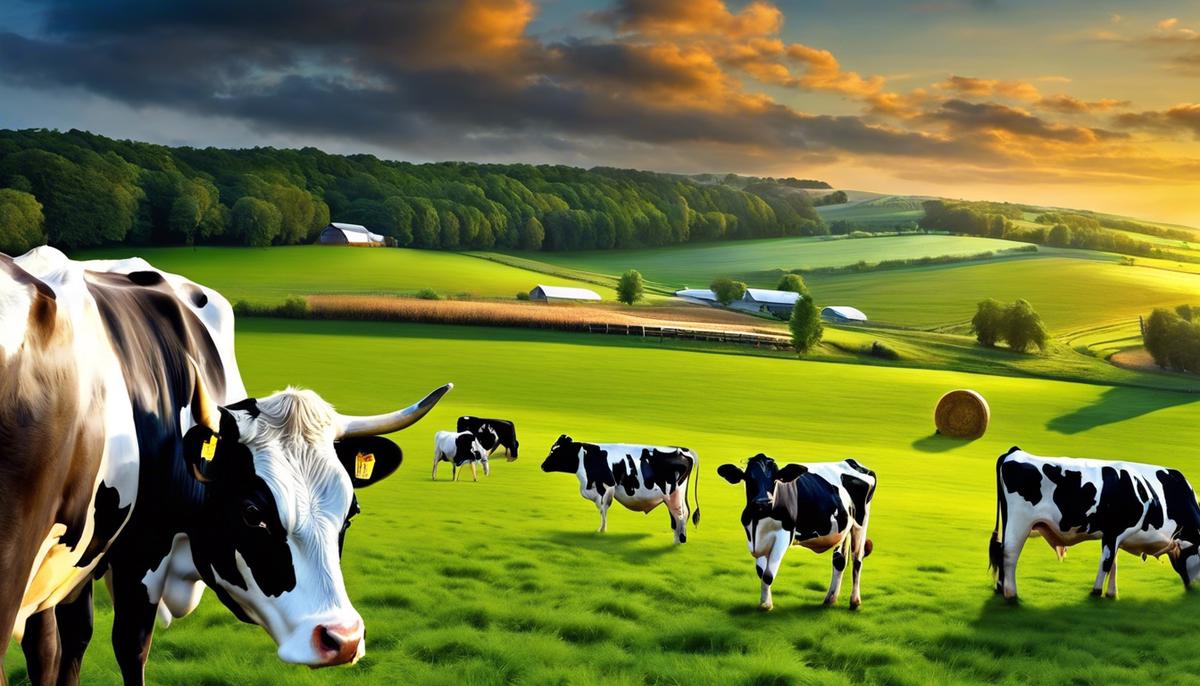
Future Directions in Dairy Farming
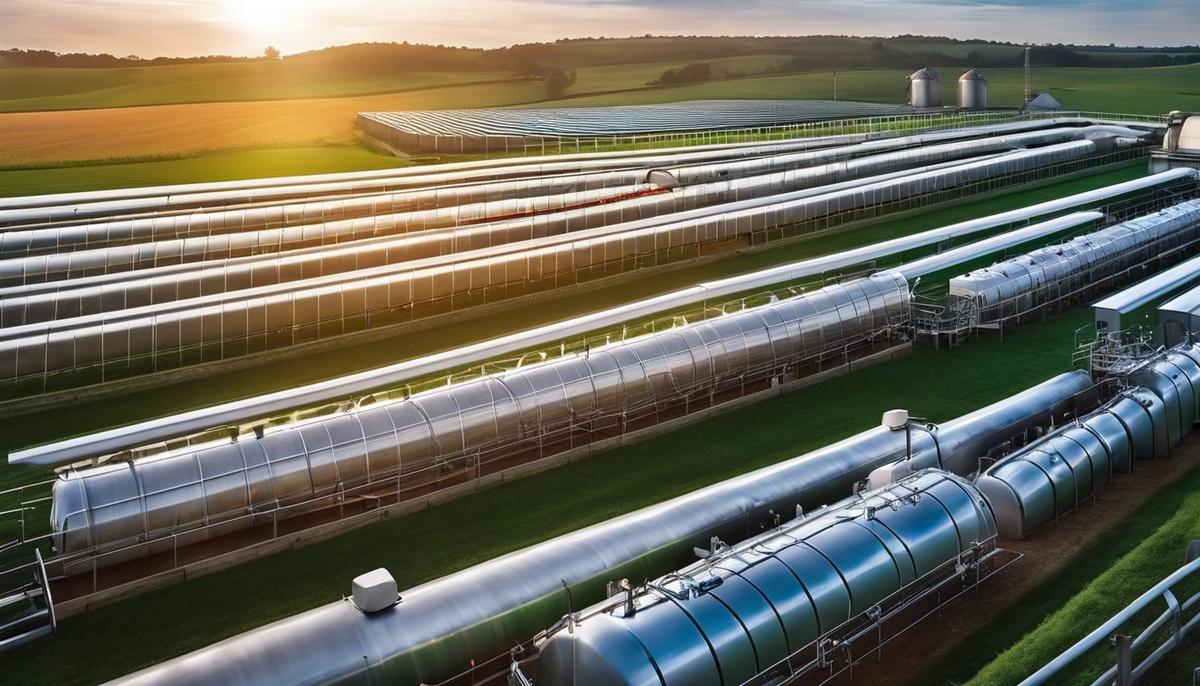
what is the trend in the modern dairy industry?
Technological Advancements in Dairy Farming
Technological Advancements in Dairy Farming: A Leap Toward Efficiency and Sustainability
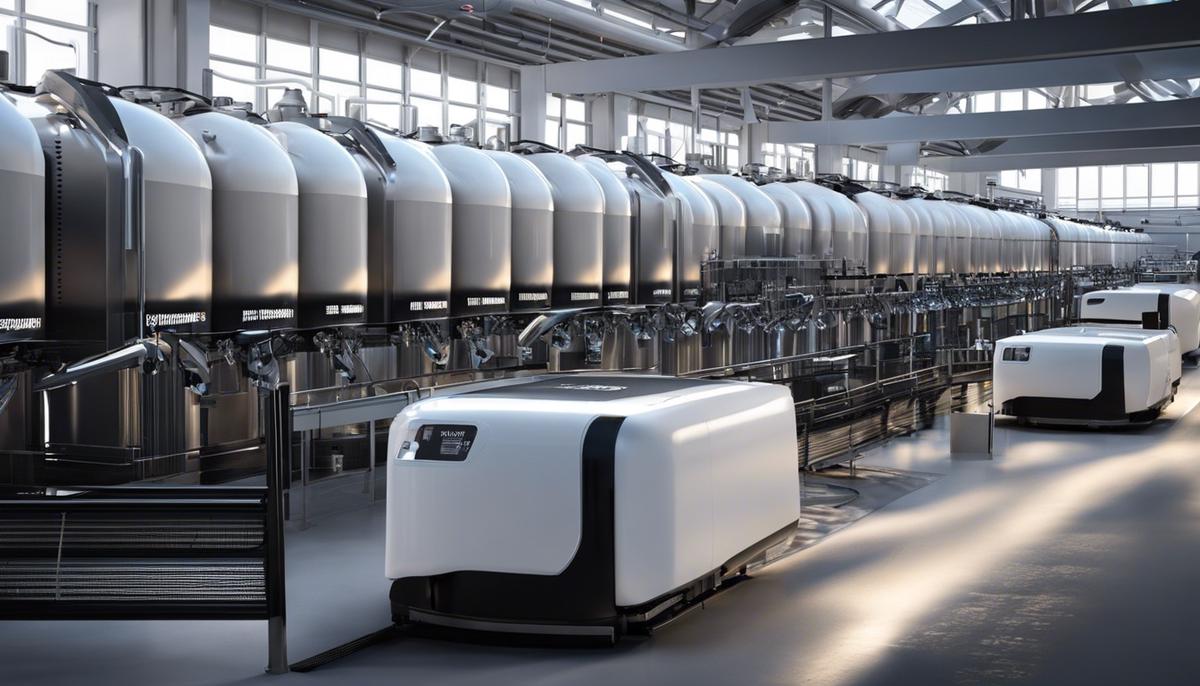
Sustainability and Environmental Impact | Modern Dairy Farming
Advancements in Eco-Friendly Feed Practices
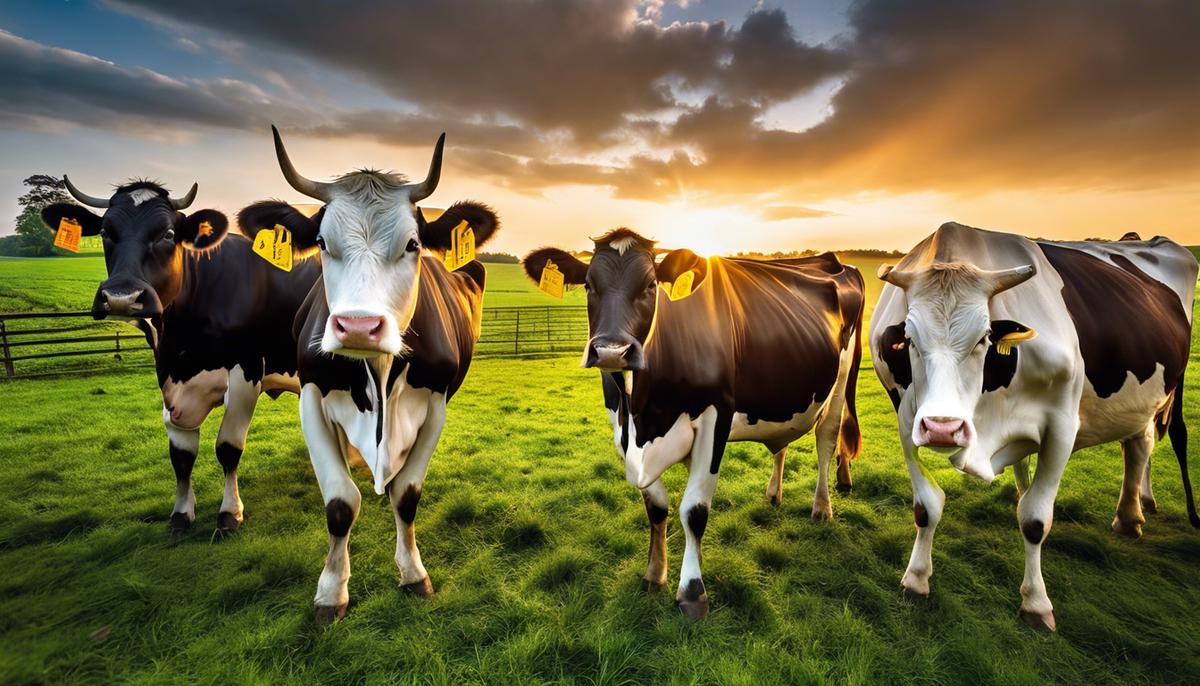
Consumer Trends and Dairy Alternatives | Modern Dairy Farming
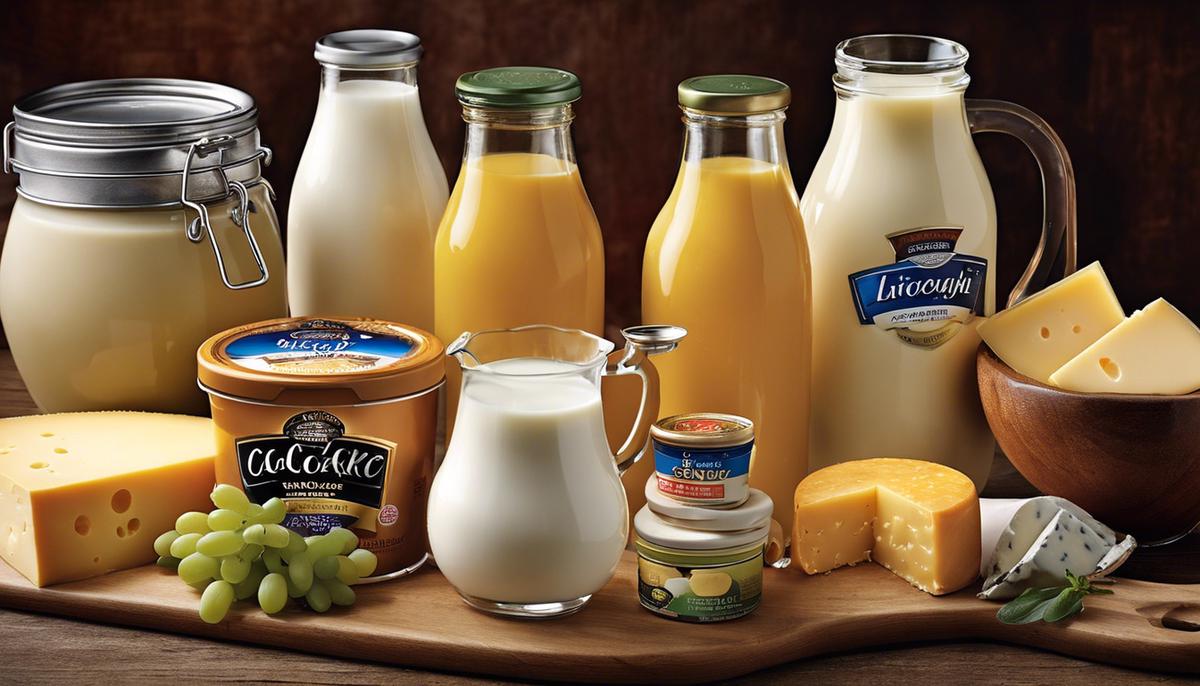
Policy and Regulatory Changes | Modern Dairy Farming
